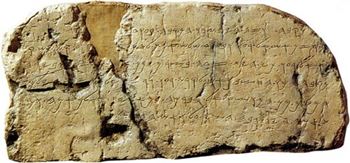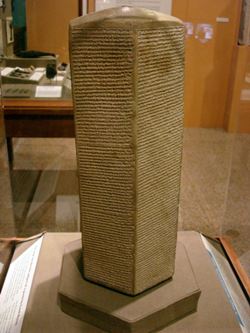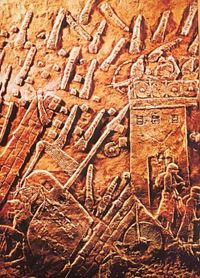Print Article
Author's Bias | Interpretation: conservative | Inclination: dispensational | Seminary: none

Hezekiah's Tunnel as
you can visit today
In 1838, biblical scholar Edward Robinson discovered a tunnel that connected the Gihon Spring, outside of Jerusalem's
walls to the Siloam Pool within its walls. The tunnel was cut out through bedrock, S - shaped with a length of 1,750
feet (1/3 of a mile), and with a slope of 0.6% which brought fresh water to inhabitants within the walls of Jerusalem.
Three biblical references explain the purpose and reason for the tunnel:
Now the rest of the acts of Hezekiah and all his might, and how he made the pool and
the conduit and brought water into the city, are they not written in the Book of the Chronicles of the Kings of
Judah? (2 Kings 20:20)
Now when Hezekiah saw that Sennacherib had come and that he intended to make war on
Jerusalem, he decided with his officers and his warriors to cut off the supply of water from the springs which were
outside the city, and they helped him. So many people assembled and stopped up all the springs and the stream which
flowed through the region, saying, "Why should the kings of Assyria come and find abundant water?"
(2 Chron 32:2-4)
It was Hezekiah who stopped the upper outlet of the waters of Gihon and directed them to
the west side of the city of David. And Hezekiah prospered in all that he did.
(2 Chron 32:30)
Jerusalem was vulnerable to any attacking force who could block and control its water supply. In preparation for
the impending siege by Sennacherib and the Assyrians (2 Kings 18:1-37;
19:1-37), King Hezekiah (reign approximately 725 B.C. – 696 B.C.)
ordered for the construction of the aqueduct which was chiseled out by 701 B.C.

The Siloam Inscription
Unbeknownst to Edward Robinson and discovered later in 1880 inside Hezekiah's Tunnel, the aqueduct's completion
was commemorated by its builders with an inscription called the Siloam Inscription. Now housed at the Istanbul Archeology
Museum, the inscription is comprised of six lines and is noteworthy as one of the oldest examples of Hebrew written in
the Paleo-Hebrew alphabet. The plaster used for the Siloam Inscription and the organic matter contained within it was
dated to the 8th century B.C. which is coincident with the time of Hezekiah.
While it is not completely legible, the Siloam Inscription describes how the tunnel was evacuated
by two teams starting at opposite ends. Led by sounds generated by hammering from above, stonecutters were guided to
each other and met at the center all the while mindful of the distance to the top of the rock. Despite having several
directional errors and misalignment of the tunnel center, the stonecutters succeeded in completing the tunnel before
the siege.
The biblical record of Hezekiah's Tunnel is remarkably accurate. Not only does the tunnel exist and
constructed at the appropriate time, but its location and flow direction is also correct: west of the City of David
and flows from east to west (2 Chron 32:30).

The Prism of Sennacherib
Extrabiblical records confirm the biblical record. In 1830, a six sided clay artifact in Nineveh was discovered,
which became known as the Prism of Sennacherib (housed at the British Museum and dated at 691 B.C.). Comprised of
six columns with over 500 lines of writing in Akkadian cuneiform, it records the first eight military campaigns of
king Sennacherib who reigned during 701-681 B.C. Of particular interest regarding the Bible is the translation about
the conquest of Judah:
"As to Hezekiah, the Jew, he did not submit to my yoke, I laid siege to 46 of his strong cities,
walled forts and to the countless small villages in their vicinity, and conquered (them) by means of well-stamped
(earth) ramps, and battering-rams brought (thus) near (to the walls) (combined with) the attack by foot soldiers,
(using) mines, breeches as well as sapper work. I drove out (of them) 200, 150 people, young and old, male and female,
horses, mules, donkeys, camels, big and small cattle beyond counting, and considered (them) booty. Himself I made a
prisoner in Jerusalem, his royal residence, like a bird in a cage. I surrounded him with earthwork in order to molest
those who were leaving his city's gate".

A wall relief showing the
sloped ramps attacking Lachish
The Bible records Sennacherib entering Judah (2 Chron 32:1),
besieging Lachish (2 Chron 32:9) and after its conquest, proceeding
to attack Jerusalem (2 Kings 18:13 -
19:37; Isa 36:1-22).
An impressive wall relief among the ruins of Nineveh portrays the conquest of Sennacherib.
Pictures of the sloping siege ramps against the city of Lachish, Assyrian warriors and Jewish captive celebrate the
victory over Lachish. However there is not one image that celebrates the conquest of Jerusalem.
The Bible records Hezekiah as seeking the help of the prophet Isaiah
(Isa 37:1-13) and praying to God for deliverance
(Isa 37:14-20). God responds though the prophet Isaiah
(Isa 37:21-35), Jerusalem does not fall, and the Assyrians are destroyed
(2 Chron 32:20-22; Isa 37:36-37).
Assyrian records indicate that after Sennacherib returned home, he was murdered by his sons. The Bible records
this as well in Isaiah 37:37-38.
References:
1. Rogerson J, Davies PR, "Was the Siloam Tunnel Built by Hezekiah?" in Biblical Archeologist, vol. 59, 1996.
2. Eshel E, "Defusing Pseudo-Scholarship: Some Paleographic Success Stories," in Biblical Archeology Review, Mar/Apr 1997.
3. Hurvitz A, "Defusing Pseudo-Scholarship: Philology Recapitulates Paleography," in Biblical Archeology Review, Mar/Apr 1997.
4. Shanks H,. "The Siloam Pool," in Biblical Archeology Review, Sept/Oct 2005.
Copyright ©
2015
Helpmewithbiblestudy.org. All rights to this material are reserved. We encourage you to print the material for personal and
non-profit use or link to this site. If you find this article to be a blessing, please share the link so that it may rise in
search engine rankings.